Summary of a study investigating the difference between successful and failed snatches of the best 73kg class Olympic weightlifters.
Who
10 male elite Olympic weightlifters (73kg weight class) competing in the 2019 World Weightlifting Championships, the 2019 Asian Weightlifting Championships, and the 2020 China Olympic Trials (World).
Design
3D video (SIMI°Motion7.50 3-D system) analysis of successful and failed snatch attempts.
Outcome measures/tests
- human and bar combination barycenter (averaged position of center of mass between lifter and barbell)
- minimal horizontal distance between the COG (center of gravity) of the barbell and the body when the barbell is rising (LHmin)
- maximal vertical rising velocity (Vmax) and the maximal vertical height of the barbell (Hbmax)
- maximum falling acceleration of the COG of the body (af), the vertical distance between the COG of the barbell and the body at the end of M4 (LHz1) and M5 (LHz2), and the vertical height of the body (Hbd5) and the barbell (Hb5) at the end of M5
- vertical displacement of the barbell
- time duration of each phase
- angles of hip and knee joints at the end of each phase
Main results
Phases of the snatch:
- first pull (M1)
- transition (M2)
- second pull (M3)
- turnover (M4)
- catch (M5)
- full stand (M6)
No difference between successful and failed lifts:
- COG of barbell and human body during the barbell rising (LHmin),
- maximal vertical rising velocity (Vmax)
- maximal vertical height (Hbmax)
- vertical height of the body (Hbd5) and the barbell (Hb5) at the end of M5
- vertical distance between the COG of the barbell and the body at the end of M5 (LHz2)
- maximum falling acceleration of the COG of the body (af)
- vertical displacement and duration time of each phase
- angle of hip, and knee joints at the end of each phase
In summary, there was no difference between successful and failed lifts in any parameters from the start of the snatch to the maximal velocity of the barbell phase
Differences between successful and failed lifts:
- vertical distance between the COG of the barbell and the body (LHz1) at the end of M4 - intertial ascent phase - was 1.95 cm larger in the successful lifts than in failed lifts. The difference came from the higher falling velocity of the lifter’s body as the barbell’s velocity and vertical height did not differ between successful and failed lifts = bigger distance between COG of the lifter and the barbell came from the athlete dropping under the barbell faster
- failed snatches were caused by the insufficient increase of human and bar combination barycenter on the X -axis (front-back) during the inertial ascent stage (M4) and the squat support stage (M5).
Take home message
Original article
Liu G, Zhu H, Ma J, Pan H, Pan X, Zhang Y, Hu T, Fekete G, Guo H, Liang M. A Biomechanical Study on Failed Snatch Based on the Human and Bar Combination Barycenter. Applied Bionics and Biomechanics. 2022 May 10;2022.
